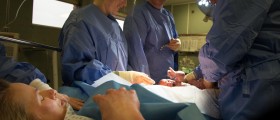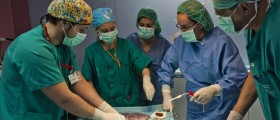Introduction and General Data
Retained placenta is a condition which features the remnant parts of the placenta after the birth of a baby. What normally happens is that after a baby is expelled through a birth canal, the placenta is expelled as well in a period that lasts no longer than an hour. When the placenta does not come out on its own, the gynecologist will assist in its elimination.
There are three types of retained placenta. The first one is the trapped placenta. In this case, the placenta has detached completely, but it is held within the uterus due to the closure of the cervix. Placenta accreta has grown too deep into the uterus and, therefore, cannot reattach properly and spontaneously. Finally, in the case of placenta adherens the contractions of the uterus are not strong enough, or there are no contractions that will assist in the placental removal.

- The prevalence of retained placenta in high-resource countries is 2.7% of vaginal deliveries. Major risk factors are previous endometrial trauma, including previous cesarean delivery, previous curettage, high parity, and a history of retained placenta, with recurrence rates of approximately 12.5%. However, data regarding risk factors among women in their first pregnancy are insufficient, making it difficult to develop preventive strategies in clinical practice.
- This retrospective case–control study included all primigravida with a singleton, live, vaginal birth at 24?weeks or later, at a tertiary hospital, 2014–2020. The cohort was divided into those with retained placenta versus controls. Retained placenta was defined as the need for manual extraction of the placenta or portions of it, immediately postpartum. Maternal and delivery characteristics, and obstetric and neonatal adverse outcomes, were compared between groups. Multivariable regression was performed to reveal potential risk factors for retained placenta.
- Among 10?796 women, 435 (4.0%) had retained placenta and 10?361 (96.0%) controls did not. Multivariable logistic regression revealed nine potential risk factors for retained placenta: abruption (adjusted odds ratio [aOR] 3.58, 95% confidence interval [CI] 2.36–5.43), hypertensive disorders (aOR 1.74, 95% CI 1.17–2.57), prematurity (
Complications of Retained Placenta
The very presence of retained placenta is a life-threatening condition. It is related to the bleeding after the child's birth. Namely, after the placenta is eliminated uterus contracts and the bleeding stops. However, if there are parts of the placenta left or in case the whole placenta is retained the uterus cannot contract properly, and the bleeding is prolonged. Huge loss of blood requires blood transfusions.
In case the placenta has completely detached from the uterine wall but cannot leave the cavum uteri, the doctor can remove it just by simple traction of the umbilical cord.
Manual removal is done in the delivery room or an operating room. The procedure is done by the very hands of the doctor. The doctor uses his/ her hands, puts them into the uterus, and pulls the placenta out of the uterus. If the removal cannot be done by hand the doctor uses additional surgical instruments. Sometimes, it is not possible to remove the whole of the placenta in one piece. In this case, the placenta is removed in parts.
The complications may occur as a consequence of manual removal of retained placenta. During the manual removal, the genital tract can be damaged, and bacteria can be introduced so that a woman may eventually end up with severe puerperal infection. Sometimes, the prophylactic usage of antibiotics may prevent the later infection.
The complication also occurs if the placenta cannot be detached from the uterus, and in these extreme cases, a woman needs to undergo a hysterectomy which is a complete surgical removal of the uterus. Without a uterus, a woman loses the ability to become pregnant again.
- www.nhs.uk/common-health-questions/pregnancy/what-complications-can-affect-the-placenta/
- americanpregnancy.org/healthy-pregnancy/labor-and-birth/retained-placenta/
- Photo courtesy of Donald Trung Quoc Don by Wikimedia Commons: commons.wikimedia.org/wiki/File:Human_placenta_being_presented_by_a_gynecologist,_Ommelander_Ziekenhuis_Groningen_Scheemda_%282019%29.jpg














Your thoughts on this
Loading...